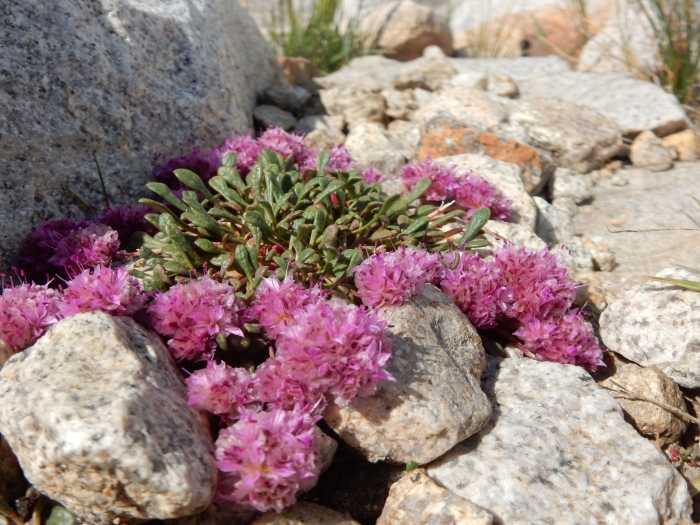Mount Hood Pussypaws
(Calyptridium umbellatum)
Mount Hood Pussypaws (Calyptridium umbellatum)
/
/

Matt Lavin
CC BY 4.0
Image By:
Matt Lavin
Recorded By:
Copyright:
CC BY 4.0
Copyright Notice:
Photo by: Matt Lavin | License Type: CC BY 4.0 | License URL: http://creativecommons.org/licenses/by/4.0/ | Rights Holder: Matt Lavin | Publisher: iNaturalist | Date Created: 2018-07-27T17:16:36-07:00 |















Estimated Native Range
Summary
Calyptridium umbellatum, commonly known as Mount Hood pussypaws, is a perennial herb native to subalpine and alpine zones in the mountain ranges of western North America, from British Columbia to California and eastward to Colorado. It typically forms basal rosettes of succulent, spoon-shaped leaves that are adapted to the harsh, rocky environments found at high elevations. The plant produces a distinctive inflorescence, which is a dense, spherical umbel composed of small, star-shaped flowers with pink to white petals and sepals, blooming from late spring to early summer. The flowers are modest in size but can be quite showy en masse due to their unique form and the contrast with the rocky soil.
Mount Hood pussypaws is valued for its ability to thrive in challenging conditions, such as rocky, well-drained soils with low nutrient availability. It is often used in rock gardens, alpine collections, and as a ground cover in areas that simulate its native mountainous habitat. This plant prefers full sun to partial shade and requires minimal water once established, making it a low-maintenance choice for suitable gardens. While not commonly afflicted by diseases, it can suffer from root rot if overwatered or planted in poorly draining soils. It is not known for being invasive or having aggressive roots, making it a safe choice for cultivation near other plants.CC BY-SA 4.0
Mount Hood pussypaws is valued for its ability to thrive in challenging conditions, such as rocky, well-drained soils with low nutrient availability. It is often used in rock gardens, alpine collections, and as a ground cover in areas that simulate its native mountainous habitat. This plant prefers full sun to partial shade and requires minimal water once established, making it a low-maintenance choice for suitable gardens. While not commonly afflicted by diseases, it can suffer from root rot if overwatered or planted in poorly draining soils. It is not known for being invasive or having aggressive roots, making it a safe choice for cultivation near other plants.CC BY-SA 4.0
Plant Description
- Plant Type: Herb
- Height: 0.1-0.5 feet
- Width: 0.1-0.5 feet
- Growth Rate: Slow
- Flower Color: Yellow
- Flowering Season: Summer
- Leaf Retention: Deciduous
Growth Requirements
- Sun: Full Sun, Part Shade
- Water: Low
- Drainage: Medium, Fast
Common Uses
Drought Tolerant, Low Maintenance, Rock Garden
Natural Habitat
Subalpine and alpine zones in the mountain ranges of western North America
Other Names
Common Names: Puget Sound pussypaws, Umbrella pussypaws
Scientific Names: , Calyptridium umbellatum, Calyptridium nudum, Calyptridium paniculatum, Calyptridium umbellatum var. umbellatum, Cistanthe umbellata, Cistanthe umbellata var. umbellata, Spraguea candicifera, Spraguea montana, Spraguea multiceps
GBIF Accepted Name: